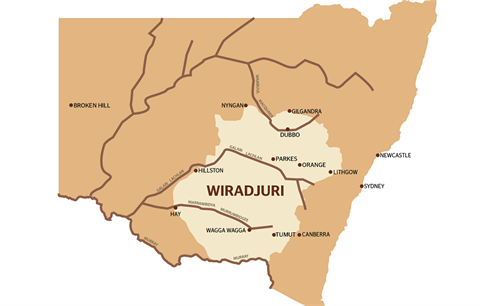Wiradjuri language

It is estimated that 12,000 people spoke the Wiradjuri language prior to white colonisation. Due to the effects of colonisation the Wiradjuri language was almost lost during the 20th century. It is now taught in classrooms at Parkes primary schools thanks to the pioneering work of Wiradjuri Elder, Dr Stan Grant, and the Wiradjuri Language Group. Many local sites and places continue to be known by their Wiradjuri name or a variation of the Wiradjuri name (often due to misunderstanding or mispronunciation).
Dr Stan Grant (Snr) and Dr John Rudder have been instrumental in the preservation and revitalisation of the Wiradjuri language in their work compiling a Wiradjuri Dictionary. A Wiradjuri Dictionary App has been developed by the Wiradjuri Study Centre providing further opportunities for people to learn and explore Wiradjuri language and culture.
Yindyamarra
Yindyamarra is a Wiradjuri way of life that is at the heart of Wiradjuri culture and lifestyle. It has many meanings and translates to respect, be gentle, polite, give honour, do slowly and take responsibility. Yindyamarra is the respectful understanding of living well with and taking responsibility for Country and community.
Watch the video here: Yindyamarra Yambuwan Respecting Everything
Local place names
Many local sites and places continue to be known by their Wiradjuri name or a variation of the Wiradjuri name (often due to misunderstanding or mispronunciation when colonisation took place). As with many First Nations place names, Wiradjuri place names often refer to the importance of the landscape, rather than possession of land or the name of a person.
More recently as a recognition of their historical importance, there has been a move to reclaim original First Nations place names with dual names, where the First Nations name is added to the English name eg Uluru / Ayers Rock, Gaahna Bulla / Mount Canobolas.
In 2020 the Parkes Radio Telescope received the Wiradjuri name Murriyang, representing Skyworld where Biyaame, a prominent creator spirit of the Wiradjuri Dreaming, lives.
- Bindugaanydhuray (Bindogundra) - having water mussel shells
- Bogan - birthplace of a great man
- Bumbal-l-dhuray (Bumberry) - sound of people splashing in water
- Bulgandramine - an Aboriginal holding a boomerang
- Condobolin - hop bush
- Coradgery - sand at a river
- Dyiimalang (Jemalong) - platypus
- Garradyang (Kurrajong) - kurrajong tree (the original settlement of Parkes)
- Gugamadhuray (Cookamidgera) - place of stumps
- Daroobalgie - to jump or dive in the water
- Goobang - acacia tree
- Mandagery - place of waterholes
- Minyambul (Magincoble) - something
- Molong - all rocks
- Nelungaloo- lizard
- Tomingly - place of death adders
- Yarrabangdhuray (Yarrabandhi) - having a big talk
- Yeugoura (Eugowra) - where the sand washes down from the hills
Wiradjuri Language app
Explore and learn the language and culture of the Wiradjuri people.
WCC Language Program online dictionary: https://wiradjuri.wcclp.com.au/
Produced by the Wiradjuri Study Centre out of Wiradjuri Condobolin Corporation.
Marrin Gamu - My Language Our Song
This video from First Languages Australia showcases a few of the hundreds of Aboriginal & Torres Strait Islander Languages of Australia in a project to provide one song for the many voices of the land. Featuring students from Parkes public schools.
Watch the video here: https://vimeo.com/99589714.